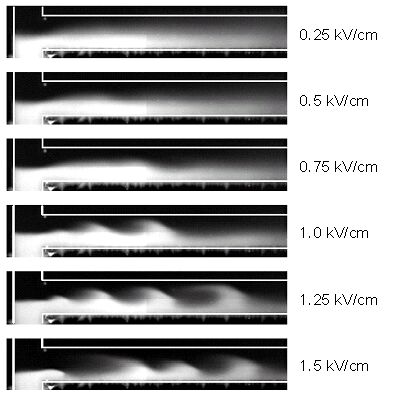Electrokinetic Instability in Microflows
With Conductivity Gradients
Motivation
As electrokinetic microfluidic systems increase in complexity, robustness to heterogeneous sample streams becomes a major concern. One critical factor is conductivity gradients in the buffer stream, which may occur due to imperfect sample preparation, or occur intentionally in sample stacking processes. We have identified and are currently studying an electrokinetic flow instability that occurs in DC-power-driven microflows with high conductivity gradients and Reynolds numbers (Re) as low as 0.05. Our aim is to provide design guidelines for complex systems by identifying the critical parameters in this instability, and to leverage the instability in a rapid field-controlled mixer that can be readily integrated with on-chip electrophoresis.
Project Description
Electrokinetic instability is demonstrated on an in-house built glass T-junction. Borate buffer of different conductivities are electrically driven from the side channels to the mixing channel. The electroosmotic flow in the mixing channel is from left to right. The bottom side channel is seeded with Rhodamine B to aid flow visualization.
The following video shows the convective nature of the electrokinetic instability induced by conductivity gradients. Upon application of unstable electric field, disturbances originate from the intersection and grow while being convected downstream.
Figure 1 shows the influence of conductivity gradient on flow stability. Given the same electric field, the flow with matched conductivity is stable, while the flow with a conductivity ratio of 10:1 is unstable.
Figure 2 shows the influence of electric field on the amplitude of instability. Given the same conductivity ratio of 10:1, instability is observed at electric field above the critical value of 0.45 kV/cm, and the strength of instability grows with growing electric field.
Currently, we are investigating the mechanisms behind the observed instability. In particular, we are developing a linear stability analysis to capture the convective instability with strong dependence on conductivity ratio and electric field strength. Please contact us for details.
References
With Conductivity Gradients
Motivation
As electrokinetic microfluidic systems increase in complexity, robustness to heterogeneous sample streams becomes a major concern. One critical factor is conductivity gradients in the buffer stream, which may occur due to imperfect sample preparation, or occur intentionally in sample stacking processes. We have identified and are currently studying an electrokinetic flow instability that occurs in DC-power-driven microflows with high conductivity gradients and Reynolds numbers (Re) as low as 0.05. Our aim is to provide design guidelines for complex systems by identifying the critical parameters in this instability, and to leverage the instability in a rapid field-controlled mixer that can be readily integrated with on-chip electrophoresis.
Project Description
Electrokinetic instability is demonstrated on an in-house built glass T-junction. Borate buffer of different conductivities are electrically driven from the side channels to the mixing channel. The electroosmotic flow in the mixing channel is from left to right. The bottom side channel is seeded with Rhodamine B to aid flow visualization.
The following video shows the convective nature of the electrokinetic instability induced by conductivity gradients. Upon application of unstable electric field, disturbances originate from the intersection and grow while being convected downstream.
Video. Convective electrokinetic instability at a microfluidic T-junction
Figure 1 shows the influence of conductivity gradient on flow stability. Given the same electric field, the flow with matched conductivity is stable, while the flow with a conductivity ratio of 10:1 is unstable.

Figure 1. Conductivity gradient induced flow instability
Figure 2 shows the influence of electric field on the amplitude of instability. Given the same conductivity ratio of 10:1, instability is observed at electric field above the critical value of 0.45 kV/cm, and the strength of instability grows with growing electric field.

Figure 2. Electric field dependence of flow instability
Currently, we are investigating the mechanisms behind the observed instability. In particular, we are developing a linear stability analysis to capture the convective instability with strong dependence on conductivity ratio and electric field strength. Please contact us for details.
References
- 1) C. H. Chen, J. G. Santiago, 2002, “Electrokinetic instability in high concentration gradient microflows”, Proceedings of 2002 International Mechanical Engineering Congress and Exposition, New Orleans, LA, CD vol.1, #33563, 2002.
